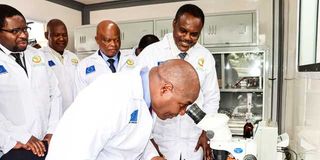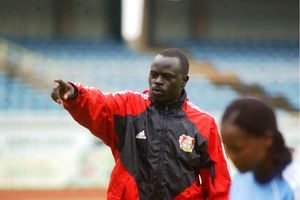Premium
Getting top animal breeds made easy

Livestock PS Hillary Kimtai examines a cow embryo during the launch of the Regional Mobile Assisted Reproductive Technologies Centre of Excellence on April 28.
Livestock farmers will now have easy access to pedigree breeds, thanks to the launch of the mobile Assisted Reproductive Technology (ART) by the African Union last week.
The programme is known as the Inter-African Bureau for Animal Research (AU-Ibar).
The mobile labs will be going to regions farmers need breed improvement services.
Livestock Principal Secretary Harry Kimtai, described the mobile ARTs as timely and a game-changer.
“The livestock sub-sector accounts for Sh200 billion of the Kenyan economy every year. We must therefore enhance technology to increase its contribution to the GDP,” the PS said.
He added that the innovation would see more women participate in livestock rearing, improving the economic standards of the society as a whole.
“Kenya has a very high per capita consumption of milk. Most of the milk produced in Uganda and Rwanda targets the Kenyan market. The mobile laboratories will ensure last-mile connectivity of quality genes,” he said.
Acting AU-Ibar Director-General, Nick Nwankpa, said the technology – which he called “Genes on Wheels” – would enhance the training of farmers and seek to establish a regional breeders association.
The two aspects of improving livestock production are in line with the organisation’s five-year programme – dubbed Live2Africa – that seeks to improve animal quality.
“It is also paramount that we improve governance of the livestock sub-sector, which will consequently improve the value chain,” Dr Nwankpa said.
“It is important for Eastern Africa to mainstream and identify available dairy production means. Demand for dairy cows and heifers is higher than supply and we must bridge this gap.”
EU representative, Stephen Wathome, said the bloc would continue supporting the programme. He added that 13 per cent of the world’s calories come from livestock milk and meat.
“It is our goal to take a continental approach to build capacity in livestock rearing. Adopting technology in the value chain is crucial and we must strengthen the capacity of AU-Ibar to improve the health and productivity of our livestock,” he said.
Dr Mary Mbole-Kariuki, the Technology Innovation and Skill Development expert at AU-Ibar, said the Mobile ART Centre became operational through collaboration with the Kenya Agricultural and Livestock Research Organisation (Kalro) and the Kenya Animal Genetic Resource Centre.
“Our mission is to support farmers so they can have breeds that will increase the communities’ and region’s livestock value chain through technology,” she said.
The biggest hurdle that confronted AU-Ibar was overcoming the cultural barrier by pastoralists, particularly in Narok County where the organisation has been conducting artificial insemination (AI).
"A bull in a jerrycan"
The pastoralists said their cows could not be served by “a bull in a jerrycan”, as they referred to AI.
“The first time they (Au-Ibar) told us that they could help us get better breeds through AI, we told them it was impossible. Now our cows can get pregnant without bulls,” Wilson Kipeno, a farmers’ representative said.
Previously having cows that produced three to four litres of milk a day, the farmers now have improved breeds that give close to 10 litres.
“We now have an ATM, which is the name we give the milk business. We would sell a bull for as little as Sh15,000. With the improved quality, we can sell one for Sh100,000,” Kipeno said.
With the benefits coming from the breeding evident and the herders’ perceptions have changed, the demand for assisted technology to improve breeds has risen.
The Principal Secretary said he was impressed by the change of attitude by pastoralists.
He added that the new technology would improve livestock breeds and livelihoods.
“It is very difficult to convince the Maa people to agree to scientific and modern means of reproduction. They are among the people who own a huge portion of Kenya’s livestock,” he said.
Kenya has the fifth largest cattle population in Africa and comes third in the total population of livestock.
The PS said an advanced embryo transplant centre is being constructed in Kirinyaga County, adding that its standards would be at par with those in Europe and other advanced economies.
“There is a need to have more mobile ARTs. There are 21 arid and semi-arid land counties that require support of this nature,” he said.
“We must put our heads together to find the best way to ensure the laboratories get to them.”





